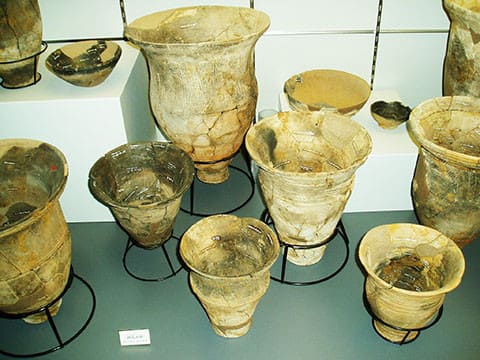



現在の札幌市は年平均気温が10°前後。ちょっと20年くらい前には8°程度と言われていたけれど、最近の温暖化の影響が大きいのかと思われます。ことしの異常な野生動物の人間界への接近遭遇には、巨視的にはこの温暖化、とくに今年かなり暑かったことが影響しているのかも知れませんね。
こうした気候変動は歴史年代に入ってもさまざまに社会的影響を及ぼしている。王朝貴族の女性たちが十二単というファッションに身を包んでいたことにも関わりがあったと言われるし、さらに江戸中期〜末期にかけての飢饉は寒冷化の直接的影響と言われる。
ざっくりとした時代ごとでは縄文時代は暖かく弥生時代は寒く、平安期にはやや温暖、江戸時代は再び寒冷化した(14〜19世紀半ばは「小氷期」とも)。
北海道札幌周辺についてどうであったか。この擦文期の遺跡からは写真のようにアワ・キビ・ヒエなどの、自然由来とはいえ人間が「管理」していたであろう植物食物が発見されているという。ジオラマ絵画では、女性たちがさまざまな植物資源を採取している様子が活写されている。
明治のごく初期からこの遺跡にほど近い「桑園」地域ではクワが栽培されたけれど、植物性資源もこの札幌・石狩中部扇状地は比較的適地であったことが偲ばれる。
わたしのようなお米大好き人間からすると、こういった穀類は心の底からうれしくなる(笑)。「おお、これならオレでも暮らしていけるかも」と思えるし、同時にこういった採取食品はどうも歴史的に女性的な雰囲気が感じられて「母の味わい」という郷愁をそそるのかも知れない。ジオラマ表現に女性たちが描かれているのは、たぶん人類史全般としてのそういう常識があるのだろうと推測。


こういった植物・穀類はそれぞれ品種毎に土器に収納されて保管され、いまの「米びつ」のように調理台所周辺に貯蔵されて、毎日の食膳を彩ったに違いない。食生活としては米のように単独で「炊き上げる」という食習慣はなかったのではないか。そうではなく、男達が狩猟・漁撈活動の結果、獲得されたサケ・エゾシカなどの動物性タンパク源との「鍋料理」として食したことが想像される。穀類は雑炊の主役として、ひとびとの食感に染みわたっていたように感じる。
おとこもおんなもそれぞれの必死な生産活動で暮らしを支え合ってきた、そういう光景が脳裏に立ち上ってくる。一方で本州社会での米作についての情報知識はあっただろう。後の時代のアイヌ期の婚姻儀礼のなかに「米を腹一杯食う」という所作があったとされる。北海道島では生産できなかった「輸入品」である米への独特の心理があったとも想像できる。
English version⬇
Exploring the rich plant and grain gathering Sapporo "Abrasive Culture" site-3
The main ingredient of one-pot dishes harmonizes with animal protein, a masculine food source obtained through heroic hunting and fishing. Grains like porridge may be a nostalgic taste of mother's cooking. ......
The current annual average temperature in Sapporo is around 10°. It was said to be around 8° a little more than 20 years ago, but recent global warming seems to have had a significant impact. The unusual encounters of wild animals with the human world this year may have been influenced by this macroscopic warming, especially the fact that it was quite hot this year.
Such climate change has had various social effects in the historical period. It is said that the fashion of the women of the royal aristocracy of the time, known as junihitoe, had something to do with this, and the famine of the mid to late Edo period is said to have been a direct result of the cold weather.
The Jomon period was warm and the Yayoi period was cold, the Heian period was slightly warmer, and the Edo period was cold again (the 14th to mid-19th century was also known as the "Little Ice Age").
What was the situation in the Sapporo area of Hokkaido? As shown in the photo, plant foods such as millet, foxtail millet, and Japanese millet, which are of natural origin but would have been "managed" by humans, have been found at the ruins of the Aburibun period. The diorama paintings vividly depict women gathering various plant resources.
Mulberry was cultivated in the "Mulberry Garden" area near the site from the very beginning of the Meiji era (1868-1912), and the Sapporo/Ishikari Chubu fan-shaped area was a relatively suitable location for plant resources.
For a rice lover like myself, this kind of grain makes me happy from the bottom of my heart (laugh). At the same time, such harvested foodstuffs have a historically feminine atmosphere, and may stimulate a sense of nostalgia for "mother's taste. I assume that the fact that women are depicted in the dioramas is probably due to the common sense of human history in general.
These plants and grains were stored in earthenware vessels for each variety, and stored around the kitchen like today's "rice cribs," and must have been part of the daily diet. They must have been stored in earthenware and stored around the kitchen like today's "rice hibi," and must have been used as a daily staple food. Rather, it is imagined that the men ate it as a "one-pot dish" with animal protein sources such as salmon and Ezo sika deer acquired as a result of their hunting and fishing activities. Grains seem to have played a leading role in the porridge, which seems to have permeated the people's palates.
The scene of men and women supporting each other's livelihood through their frantic production activities rises up in my mind. On the other hand, they probably had information and knowledge about rice cultivation in the mainland society. It is said that in the Ainu marriage rituals of later times, there was a custom of "eating a full meal of rice. It can be imagined that there was a unique mentality toward rice, an "imported product" that could not be produced on the island of Hokkaido.



















